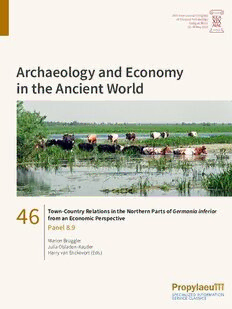
Town-Country Relations in the Northern Parts of "Germania inferior" from an Economic Perspective: Panel 8.9 PDF
Preview Town-Country Relations in the Northern Parts of "Germania inferior" from an Economic Perspective: Panel 8.9
19th International Congress of Classical Archaeology Cologne/Bonn 22–26 May 2018 Archaeology and Economy in the Ancient World 46 Town-Country Relations in the Northern Parts of Germania inferior from an Economic Perspective Panel 8.9 Marion Brüggler Julia Obladen-Kauder Harry van Enckevort (Eds.) Proceedings of the 19th International Congress of Classical Archaeology Volume 46: Town-Country Relations in the Northern Parts of Germania inferior from an Economic Perspective Proceedings of the 19th International Congress of Classical Archaeology Cologne/Bonn, 22 – 26 May 2018 Archaeology and Economy in the Ancient World Edited by Martin Bentz and Michael Heinzelmann Volume 46 Edited by Marion Brüggler – Julia Obladen-Kauder – Harry van Enckevort Town-Country Relations in the Northern Parts of Germania inferior from an Economic Perspective Panel 8.9 Bibliographic information published by the Deutsche Nationalbibliothek: The Deutsche Nationalbibliothek lists this publication in the Deutsche Nationalbibliografie; detailed bibliographic data are available on the Internet at http://dnb.dnb.de. This work is published under the Creative Commons License 4.0 (CC BY-SA 4.0). The cover is subject to the Creative Commons License CC BY-ND 4.0. Published at Propylaeum, Heidelberg University Library 2020. This publication is freely available under https://www.propylaeum.de (Open Access). URN: urn:nbn:de:bsz:16-propylaeum-ebook-727-7 DOI: https://doi.org/10.11588/propylaeum.727 Text © 2020 the authors. Editorial Coordination: Florian Birkner, Ina Borkenstein, Christian Schöne Editorial Staff: Stefanie Herten, Katharina Zerzeropulos Layout: Torsten Zimmer, Zwiebelfisch@quarium Cover illustration: Cows coming home after a day of grazing in the flood basin of the Biebzra (Poland) in 1995. The scene could have taken place in Roman times on the Lower Rhine. Photo: L. I. Kooistra ISBN: 978-3-948465-87-2 e-ISBN: 978-3-948465-86-5 CONTENTS Julia Obladen-Kauder Vergleichende Ergebnisse der Beziehungen zwischen Stadt und Land der civitas Batavorum (mit Oppidum, Ulpia Noviomagus und Militärstandort) sowie der civitas Cugernorum (mit vorcoloniazeitlicher Siedlung und Colonia Ulpia Traiana): Siedlungsstrukturen, Landwirtschaft und Ernährung 1 Harry van Enckevort Stones, Tiles, Temples and Villas. A Social-Economic Transformation of the civitas Batavorum (85–120 AD) 7 Laura I. Kooistra – Maaike Groot Supplying Food to Ulpia Noviomagus Batavorum 19 Christoph Eger Colonia Ulpia Traiana: The Economy of a Garrison and Border Town at the Lower German Limes 35 Marion Brüggler – Renate Gerlach – Jutta Meurers-Balke – Tanja Zerl – Michael Herchenbach The Hinterland of the Colonia Ulpia Traiana (Xanten): Supply Basis for the Town? 41 PREFACE On behalf of the ‘Associazione Internazionale di Archaeologica Classica (AIAC)’ the 19th International Congress for Classical Archaeology took place in Cologne and Bonn from 22 to 26 May 2018. It was jointly organized by the two Archaeological Institutes of the Universities of Cologne and Bonn, and the primary theme of the congress was ‘Archaeology and Economy in the Ancient World’. In fact, economic aspects permeate all areas of public and private life in ancient societies, whether in urban development, religion, art, housing, or in death. Research on ancient economies has long played a significant role in ancient history. Increasingly in the last decades, awareness has grown in archaeology that the material culture of ancient societies offers excellent opportunities for studying the structure, performance, and dynamics of ancient economic systems and economic processes. Therefore, the main objective of this congress was to understand economy as a central element of classical societies and to analyze its interaction with ecological, political, social, religious, and cultural factors. The theme of the congress was addressed to all disciplines that deal with the Greco-Roman civilization and their neighbouring cultures from the Aegean Bronze Age to the end of Late Antiquity. The participation of more than 1.200 scholars from more than 40 countries demonstrates the great response to the topic of the congress. Altogether, more than 900 papers in 128 panels were presented, as were more than 110 posters. The publication of the congress is in two stages: larger panels are initially presented as independent volumes, such as this publication. Finally, at the end of the editing process, all contributions will be published in a joint conference volume. We would like to take this opportunity to thank all participants and helpers of the congress who made it such a great success. Its realization would not have been possible without the generous support of many institutions, whom we would like to thank once again: the Universities of Bonn and Cologne, the Archaeological Society of Cologne, the Archaeology Foundation of Cologne, the Gerda Henkel Foundation, the Fritz Thyssen Foundation, the Sal. Oppenheim Foundation, the German Research Foundation (DFG), the German Academic Exchange Service (DAAD), the Romano-Germanic Museum Cologne and the LVR-LandesMuseum Bonn. Finally, our thanks go to all colleagues and panel organizers who were involved in the editing and printing process. Bonn/Cologne, in August 2019 Martin Bentz & Michael Heinzelmann
